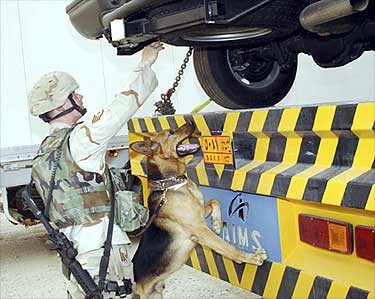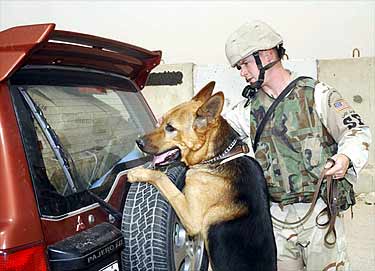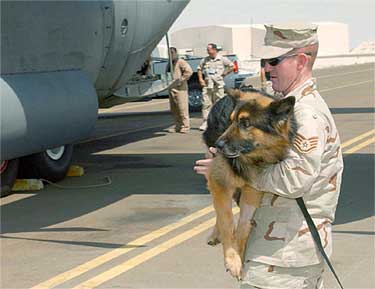
- The reply from our troops to Senator
Kerry's
- in reference to his "stupid" comment.
-



SOUTHERN IRAQ -- Doran, a 4-year-old explosive patrol dog, searches
civilian vehicles at a remote location as his handler, Staff Sgt.
Gregory Long, directs him to potential hiding spots. They are assigned
to the 407th Expeditionary Security Forces Squadron at Ali Base. (U.S.
Army photo by Master Sgt. Lek Mateo)
-
Military working dogs:
-
More than man’s best
friend
by Army Master Sgt. Lek Mateo 56th Brigade
Combat Team Public Affairs
7/12/2005 - ALI BASE, Iraq (AFPN) -- Dogs are known
as man’s best friend, but to Airmen and Soldiers here, military working
dogs are considered a four-legged partner in the war against terrorism.
Security forces Airmen and Soldiers, along with their military working
dogs, have partnered together to provide force protection on this
sprawling Air Base that is home to thousands of coalition service
members and civilians.
In the eyes of the Air Force, the dogs are considered valuable property,
like an F-16 Fighting Falcon, said Tech. Sgt. Terri Frye, 407th
Expeditionary Security Forces Squadron’s kennel master who is deployed
from Hurlburt Field, Fla. But to her and many of the handlers she works
with, their dogs are much more than that. Although the handlers
understand that the dogs are Air Force property, they cannot help but
become attached to their dogs after years of working with them side by
side, she said.
“Your dog is your best friend,” Sergeant Frye said. “And you will always
remember the dogs that you have worked with.”
Staff Sgt. Gregory Long, a dog handler here deployed from Mountain Home
Air Force Base, Idaho, said he has always been around dogs, having grown
up on a cattle farm.
Part of the job for Sergeant Long and his 4-year-old German shepherd
explosive patrol dog, Doran, is to search vehicles that come onto base.
Although some searches net contraband, Sergeant Long said their mere
presence also provides a deterrent to bad guys, especially when they see
Doran’s sharp fangs. He compared Doran’s teeth to 42 bullets that can
exert 350 to 400 pounds of pressure per square inch in a bite -- enough
to break a man’s arm. Nevertheless, the two share a close bond.
“Doran is my partner,” Sergeant Long said. “He looks out for me, and I
look out for him, and he is a partner that I would trust my life to.”
Here, Sergeant Long has also struck up a partnership with his Army
counterparts.
Army Staff Sgt. James Demaree said he thinks it is a good idea to have
joint patrols with the Air Force not only because they foster a good
working relationship, but also, and more importantly, because the job
they perform benefits everyone here.
“The Air Force security forces and their dogs provide a service that
helps us ensure that we can have a better level of force protection for
our Soldiers and Airmen based here,” Sergeant Demaree said.
The natural instincts a dog possesses contribute tremendously to their
arsenal for deterring attacks, Sergeant Demaree said.
“The dog is definitely an important asset,” he said. “He has keen senses
like his smell and hearing that are well beyond ours and that definitely
make him a combat multiplier.”

-
Military
working dog
-
aerovaced after operation, hospitalization
by
1st Lt. Kelley Jeter
380th Air Expeditionary Wing Public Affairs
8/23/2004 - SOUTHWEST
ASIA (AFPN) -- Staff Sgt. Tim Cox and military working
dog, Ronny, have been partners for more than two years, so when the
canine cop fell ill on the job recently, Sergeant Cox instantly
recognized a problem.
“He just had a complete change of attitude,” Sergeant Cox said.
“He got very lethargic and wasn’t himself at all.”
Ronny’s change in behavior was a red flag that he needed immediate
medical attention, and he was taken to a veterinary facility in a city
near a forward-deployed location. The veterinarian discovered Ronny had
a relatively common malady for large-breed dogs called pericardial
effusion. It is an unnatural collection of fluid around his heart that
began interfering with the heart’s functioning. He was immediately
operated on.
“He was put into the equivalent of doggie ICU for three days,” said
Maj. David Blocker, 380th Expeditionary Medical Group’s aerospace
medicine chief.
Ronny’s heartbeat was irregular for two days after the emergency
procedure, which drained the excess fluid off his heart. He was hooked
up to a heart monitor, put on oxygen and closely observed until he was
out of the danger zone.
Army Capt. (Dr.) Todd Bell, a veterinarian assigned to Navy Central
Command headquarters, was summoned to assess Ronny’s condition and
assist in a medical evacuation if needed.
“This condition will often resurface six to eight weeks after the
initial episode,” Dr. Bell said.
The possibility of Ronny getting sick again cemented the decision to
send him to Germany, where he could get a specialty evaluation and maybe
a special surgery to permanently fix the condition.
Major Blocker has arranged plenty of aeromedical evacuations for people,
but said this was his first experience with moving a sick dog. The
aerovac system requires frequent stops and medical re-evaluation to
guarantee that people will have the medical care they need available in
flight and at every step along the way.
“People may often go home for medical reasons, but not all of them
need medical care en route,” he said.
Many can be sent home commercially or on a military rotator and will
usually make it home anywhere from five to seven days sooner than if
they are locked into the aerovac system.
Unlike people, medics have very few options with regard to moving sick
dogs. Ronny needed the constant presence of health-care professionals
and a trained eye to watch his condition, should it change; that made
aerovac the ideal choice. Military working dogs like Ronny are
considered to be active-duty servicemembers eligible for aerovac.
To get him safely to Germany for further triage, Ronny was escorted by
Dr. Bell and Sergeant Cox on a special aerovac flight Aug. 22. From
there, they will decide whether to treat him in Germany, or to send him
home to Texas to get treated.
Sergeant Cox and Ronny are both deployed from Dyess Air Force Base,
Texas, but the treatment facility for military working dogs is at
Lackland AFB, Texas. They were assigned to the 380th Expeditionary
Security Forces Squadron here, where Sergeant Cox and Ronny worked at
the vehicle search area checking incoming vehicles for explosives.
Military working dogs’ training can run anywhere from $20,000 to
$60,000 before they are ready to work. Training them to sniff out drugs
or explosives, and teaching them to attack on command helps keep service members
and assets safe from outside threats.
After Ronny’s evaluation and possible surgery, he will have about 30
days to recover, and he will be back home and working at the job he has
been trained to do.

SOUTHWEST ASIA -- Staff Sgt. Timothy Cox carries his military working
dog, Ronny, to a C-130 Hercules on Aug. 22, 2004 for an aeromedical
evacuation to Germany. Ronny was diagnosed with pericardial effusion, an
unnatural collection of fluid around his heart that began interfering
with the heart's functioning. Sergeant Cox and Ronny are assigned to the
380th Expeditionary Security Forces Squadron at a forward-deployed
location. (U.S. Air Force photo by Staff Sgt. Lee Tucker)
(Story re-printed courtesy of AFNEWS -
Air Force Print News http://www.af.mil/news/
)





